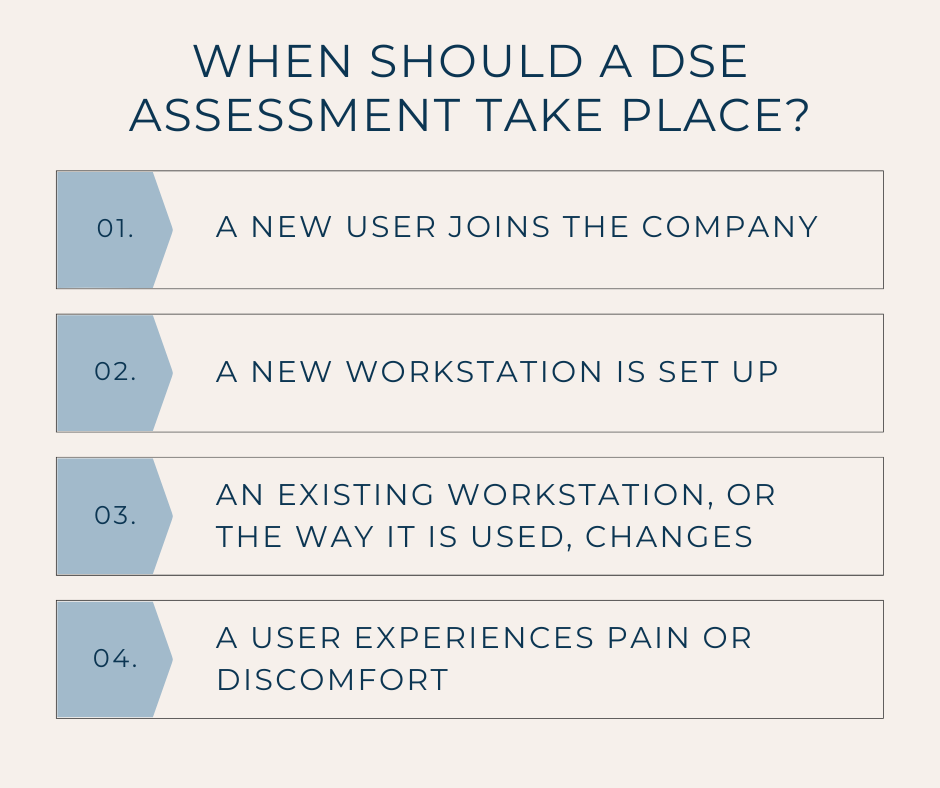As part of September’s Hazard of the Month, Display Screen Equipment, we’re highlighting two key areas: Display Screen Equipment and Lone Working.
Display Screen Equipment
 For any workers that use display screen equipment daily, continuously for an hour or longer, and as part of their regular role, employers must undertake a workstation assessment as per the Health and Safety (Display Screen Equipment) Regulations.
For any workers that use display screen equipment daily, continuously for an hour or longer, and as part of their regular role, employers must undertake a workstation assessment as per the Health and Safety (Display Screen Equipment) Regulations.
This assessment should include:
- An assessment of the entire workstation, inclusive of equipment, furniture and working conditions
- Looking at the tasks being carried out by the worker
- Any special requirements by the display screen equipment user, such as those with a disability
- Identifying any risks, and implementing steps to reduce these
There are multiple scenarios when an assessment should be completed, including when:
- a new user joins the company
- a new workstation is set up
- an existing workstation, or the way it is used, changes
- a user experiences pain or discomfort
Additionally, it is inevitable that things will change over time – people may develop new habits, their bodies may change, or furniture may deteriorate. Therefore, it is recommended that you re-assess workstations on a regular basis to ensure that they are still suitable for their users. Here at WA Management, we re-assess our stations every year, and would recommend a similar schedule.
Learn about the importance of correct posture and workstation set-ups with our Display Screen Equipment E-learning course. Get 10% off this course with the code ‘dse10’!
Lone Working
 Lone workers can be found in many professions – from construction and security staff to freelancers and remote workers, lone working is prevalent in a number of industries. Anyone who works alone for all our most of their day, on a regular basis, and without close or direct supervision is defined as a lone worker.
Lone workers can be found in many professions – from construction and security staff to freelancers and remote workers, lone working is prevalent in a number of industries. Anyone who works alone for all our most of their day, on a regular basis, and without close or direct supervision is defined as a lone worker.
For any lone workers who work from home, a display screen equipment assessment should also be carried out as above. This can be achieved by the worker supplying photographs of their set ups, or completing a self-assessment questionnaire.
Employers have the same health and safety responsibilities for homeworkers as they would for any other employees, which means that you must provide sufficient and appropriate supervision, education and training.
The level of supervision required will depend on the amount of risk the worker faces in their role – those with roles that carry a lot of risk, such as a construction worker, will need more supervision than an employee working in a home office. Even so, it is important to regularly check in with your employees to ensure they feel connected and part of the team, and to keep an eye out for signs of stress or poor mental health.
Lone workers may require more training than other employees, as they will not have colleagues around to assist them. Make sure that they are fully trained not only in the requirements for their role, but also in understanding the risks in their work and how to control them.
Make sure your lone working employees understand how to stay safe with our Lone Working E-Learning Course. Get 10% off this course with the code ‘dse10’!

Display Screen Equipment and Lone Working. training courses are essential tools in protecting the health and safety of your employees. Make sure you don’t miss out on our 10% off deal on these courses, available until the end of September. Simply enter the code ‘dse10’ at checkout to save!
Read more Safety Spotlight blogs here
To keep up to date with the latest health & safety news and advice, follow us on social media:
